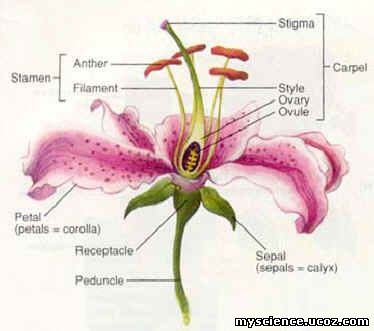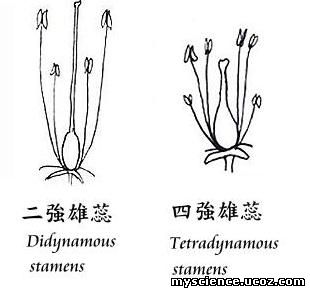Flower It is a modified and condensed aerial shoot useful for reproduction. Scientists like Linnaeus, Gothe, and de Candolle and Gaspard bauhin described flower as a modified aerial stem. Generally in angiospermic flower, apical part of the pedicel known thalamus consists nodes and internodes known as floral leaves (or) floral parts. Ø Parts of a Flower · Calyx/Sepals: It is the outermost whorl of the thalamus which protects and attracts for pollination hence also known as non-essential or accessory whorls. Note: Calyx and Corolla combinely known as perianth lobes. · Corolla/Petals: It is the second whorl of a flower which protects and attracts for pollination hence also known as non-essential or accessory whorls. 
· Androecium/Stamens: It is the third whorl of the thalamus consisting stamens with a long stalk known as filament and anther lobes which helps in reproduction hence also known as essential or reproductive whorls. · Gynoecium/Ovary: It is the innermost whorl of the thalamus differentiated into ovary, style and stigma which helps in reproduction hence also known as essential or reproductive whorls. Ø Structure of Flower Flower has two sides, one side with bract (anterior) and other towards axis (posterior) · Bracteate: Flower with bract. · Ebracteate: Flower without bract. · Bracteolate: Flower with bracteole · Ebracteolate: Flower without bracteole. · Complete: Flower with 4 parts. · Incomplete: Flower only with 3 parts. · Pedicillate: Flower with pedicel. · Sessile: Flower without pedicel. Ø Sex distribution Based on the sexuality of a flower they are of 2 types as follows · Unisexual/Imperfect flower: flower with either androecium or gynoecium and are of 2 types · Male/Staminate flower: flower with androecium. Example: Pumpkin. · Female/Pistillate flower: Flower with gynoecium Example: Hibiscus. · Bisexual/Perfect flower: flower with both androecium and gynoecium. Example: Datura. Ø Types of flowers Based on the presence of flowers they are of 3 types as follows · Monoecious: Both male and female flowers present on the same plant.Example: Coconut. · Dioecious: Both male and female flowers present on different plants.Example: Papaya. · Polygamous: Unisexual and bisexual flowers present on the same plant.Example: Mango. Ø Symmetry Based on the symmetry they are of 3 types as follows · Actinomorphic flower: Flower can be divided into two equal halves in any plane. Example: Hibiscus · Zygomorphic flower: Flower can be divided into two equal halves in only one plane. Example: Dolichos. · Asymmetric flower: Flower cannot be divided into 2 equal halves in any plane. Example: Achira Detailed Description of Flower The important parts of the flower are as follows Ø Bract The condensed leaf like structure on the peduncle called as bract. The flower arises in the axils of bract which protects the flowers in bud condition. Some bracts perform special functions like · Foliacious bract: Modified into leaf like structures.Example: Acalypha Petaloid bract: Developed into coloured petal like structures Example: Bougainvillea. Involucre bract: Fused and gives protection. Example: Allium cepa. Glumes:Reduced and present on the axis of spike. Example: Oryza sativa.
Ø Calyx These are non-essential organs of a flower which are thin, expanded and green colour gives protection to the flower. · Forms of Sepals o Polysepalous: Sepals are free. Example: Custard apple. o Gamosepalous: Sepals are united. Example: Hibiscus. o Petaloid sepalous: Brightly coloured & look like petal.Example: Tamarindus. o Pappus calyx: Reduced to hair like structures. Example: Helianthus. · Functions ü Protects the floral parts in bud condition. ü Supports the floral parts present on thalamus. ü Attracts the insects of pollination. ü Performs the photosynthesis hence appears as a fleshy part. Epicalyx: It is present at the base of the calyx as a small bracteate.Example: Rose Ø Corolla These are non-essential organs of a flower which hare coloured and attractive helps in pollination. · Polypetalous: Petals are free. Example: Dolichos. · Gamosepalous: Petals are united. Example: Tridax · Functions ü Protects the floral parts in bud condition. ü Attracts insects for pollination. ü Edible in few flowers(Rose) ü Shows distinct petals and sepals called as tepals or perianth lobes. Ø Aestivation The mode of arrangement of perianth lobes during bud conditions known as aestivation and are 4 types · Valvate aestivation (1+1+1+1+1): Perianth lobes are arranged closely with small gaps. Examples Cabbage, Custard apple. · Twisted aestivation (1+1+1+1+1):Perianth lobes overlaps with each other(one margin out and one margin in) Examples: Datura, Hibiscus. 
· Imbricate aestivation (1+1+2): One perianth lobe is completely inside and one is outside. Remaining overlaps with each other.Example: Tamarindus · Quincuncial aestivation (2+2+1): Two perianth lobes are completely inside and two outside, remaining one overlaps. Example: Sweet potato.
Ø Androecium It is the essential organ consisting stamens also called as microsporophyll’s helps in producing pollen grains. ü Sterile stamens are known as staminode. ü Fertile stamens are known as microsporangium · Structure of stamen Each stamen has three parts namely filament, anther and connective. It bears one or two sac like structure known as anther lobes. The anther lobes and filaments are united by a connective and are different in different flowers. · Types of stamens Based on the anther lobes they are two types as follows ü Dithecous: Two anther lobes. Example: Datura. ü Monothecous: Only one anther lobe.Example: Hibiscus. Based on the length of the filaments they are of two types as follows ü Didynamous: Four stamens, two are long and two are short. Example: Ocimum ü Tetradynamous: Six stamens, four are long and two are short. Example: Brassica.

Based on the variations the number of stamens is of two types as follows ü Definite stamens: If the number of stamens in a flower is below 20. ü Indefinite stamens: If the number of stamens in a flower is beyond 20.They are of many types as follows · Monoandrous: Flower with one stamen. Example: Poinsettia. · Diandrous: Flower with two stamens. Example: Mangrooves · Triandrous: Flower with three stamens. Example: Bamboo · Tetrandrous: Flower with four stamens. Example: Ocimum · Pentandrous: Flower with five stamen. Example: Datura · Hexandrous: Flower with six stamens. Example: Brassica · Polyandrous: Flower with many stamens. Example: Hibiscus Based on the union of stamens they are of two types · Cohesion: Stamens are united with each other. · Adhesion: Stamens are united with calyx, corolla and gynoecium. · Dehiscence of anthers: Rupturing of anthers Example: Datura.
Continuation in Part 2
| 




